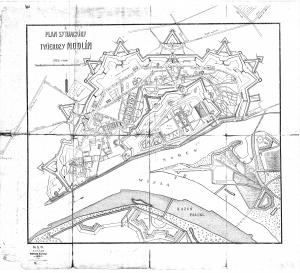The Polish Culture
Since its beginning, also the Poles had contributed to the heritage of the Modlin Fortress. In the Napoleon times, the fortification works were supervised by Polish military engineers like, for example, Ignacy Prądzyński. The Modlin Fortress has also played an important role in crucial events of the Polish history. They included, for instance, the November Uprising when the Fortress fell into the hands of the insurgents and was a support to the Polish army. Then, the fortification works were also conducted under the management of August Szulc and Ignacy Ledóchowski, the commander of the Fortress. At that time, the mistakes committed by the French designers were corrected. High hopes were raised also in the plans of the January Uprising. Unfortunately, the conspiracy aimed at taking over the ammunition warehouses existing in the Fortress had been uncovered. It is interesting enough that a great rebuilding of the Fortress by Russians under the supervision of General Ivan Dhen was carried out according to the indications left by Ignacy Prądzyński and in cooperation with engineers of Polish descent.
The Polish period in the history of the Modlin Fortress began at the end of World War I when the German crew was disarmed by a group of Polish soldiers. The Polish Army took over the power and Colonel Edward Malewicz became the commander of the Modlin Fortress.
Soon after the Wold War I, yet another important test awaited the Fortress. The Polish-Bolshevik war broke out.
After the fighting ended and in spite of war damages, the Modlin Fortress remained an important military garrison and also played a significant role as a centre of military education. The Fortress accommodated: the Cadets’ Corps, The Armoured Weapons School of Cadets, and the Sapper Training Centre. Also the infantry, sapper and engineer units were stationed here. On 8 November 1918, on a decree by Józef Piłsudski, the Polish Navy was established and its first harbour was the Modlin Fortress. Also a shipyard was constructed here where smaller ships were built.
In the pre-war period, the status of the Fortress was altered into a fortified camp. The construction works were limited to the maintenance of the facilities and reinforcement of the forts. It was the time when a Power Station was built which was set in motion by the Electro-Technical Battalion in 1924. Also several blocks of apartments for the military personnel were erected. The former Russian church was denominated into a Roman Catholic church. Just before the outbreak of World War II, the combat shelters were built.
In September 1939, the Modlin Fortress became an important stronghold in defence of Warsaw. It was defended by 17 thousand troops. After heroic struggle, the Modlin Fortress surrendered as late as on 29 September, a day after the surrender of Warsaw.
After World War Ii, several thousand troops were stationing in the Fortress. Then, many facilities were demolished including the church in the barracks’ courtyard. A building of the military airfield began. In 1958, an elite Higher School of Pilots was established here which has trained thousands of pilots. Also the pilots from the 45th Flying Experimental Squadron were flying in the Modlin sky. Today, the aeroplanes of the Warszawa-Modlin Mazovian Airport – a civilian airfield established on the basis of the former military airfield are flying over the Fortress.
The facilities from the beginning of the 20th century which have been preserved in the Fortress include – the fort cemetery, probably established by Germans (the first tombstone comes from 1915). The cemetery was then used as a burial place of the victims of the 1914-1939 wars as well as those who were killed during World War II. Also members of the families of the garrison troops were buried at the necropolis.






